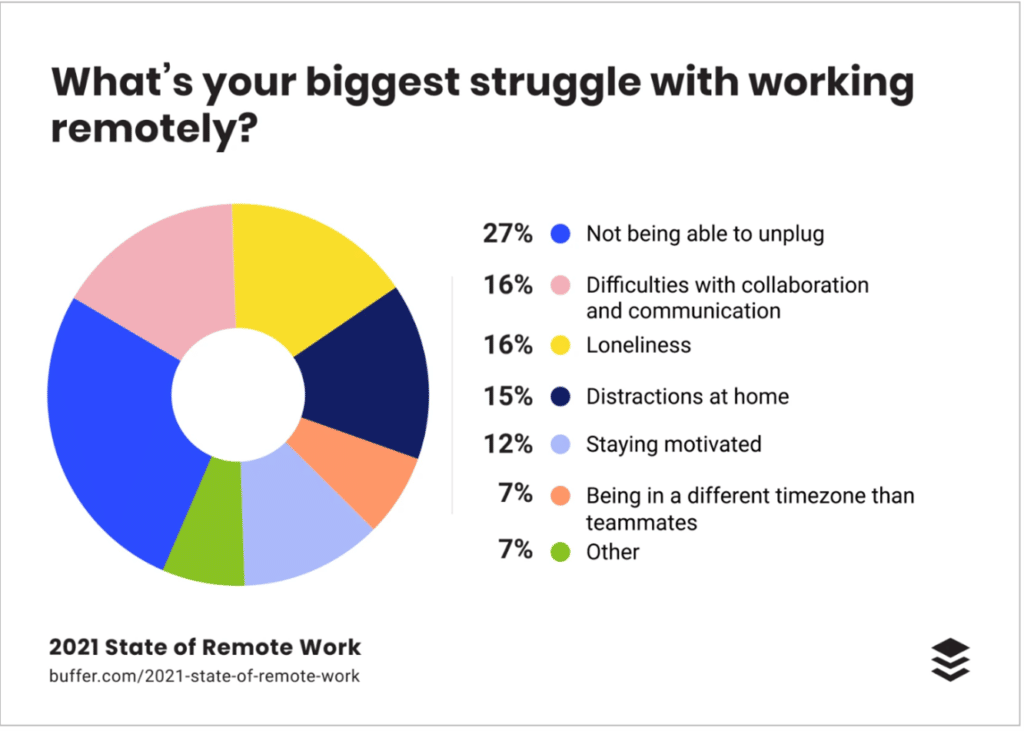The world of work changed during the Covid-19 pandemic, which has enabled remote and hybrid work. Employees love its flexibility, more autonomy, and the elimination of commutes. However, they report difficulties with overworking, too few communications, and loneliness. Managers will need to improve their listening skills, set new working norms, and incorporate innovative digital tools for hybrid teams to be successful.
Remote and hybrid work models have changed managers’ informal communication routines and socialization patterns with and between employees. Casual office conversations seldom occur anymore. Fewer employees attend “in-office” meetings and when they are on video calls, many keep their cameras off. When employees have fewer discussions and spend less time looking into each other’s eyes, it weakens the relationship and trust, previously established through meetings in offices or workplaces.
Research released in February 2022 by Pew Research shows that 61 percent of employees choose working from home. Two years ago, the same percentage flipped. In 2020, 61 percent of employees worked from home to avoid exposure to Covid-19.
Workplace Transformation Underway
With the global pandemic becoming an endemic, many employers have required their employees to report to the office three to five days a week. The New York Times reports that optimism about return-to-office plans, across industries and cities, is slowly abating. For example,
- Apple recently suspended its requirement that employees return to the office at least three days a week.
- Google postponed its return to the office planned for January, and by now roughly 10 percent of its employees have received permission to go fully remote or relocate.
- Intuit had at one point considered a rigid return-to-office plan for its 11,500 U.S. employees. Currently, managers and teams set their own expectations of which days to go into the workplace.
Top Five Struggles of Remote Workers.
Workers having a say on when and where they work is here to stay. Now managers need to hone in on their listening skills and set new operating norms with their hybrid or remote worker teams.
According to the 2021 State of Work Report by Buffer, the biggest struggles for remote workers are not being able to unplug, difficulties with collaboration and communications, loneliness, distractions at home, and staying motivated.

Below are recommended operating norms from Global Workplace Analytics research:
- To address loneliness and improve communications, managers should casually greet their employees daily as they did when everyone came into the office. But it is virtual. In addition, practice what Harvard Professor Tsedal Neeley calls “I am here for you.” Remote working team members need frequent contact from their team leaders. This can be accomplished through a brief phone call, email, or through the flow of work as a message in their collaboration environment (i.e., Slack or Teams). It’s important to convey that their individual contributions matter, ask them for their specific input on a critical decision, thank them for their input, or recognize a birthday.
- Managers can address collaboration through motivation and establishing team norms for the hybrid workforce. These agreements should cover the following:
- Set schedules for weekly staff meetings as well as manager and employee one-on-one meetings. With hybrid work, it is essential to provide continual clarity on the organization’s mission, goals, milestones, and how the team and each employee’s role fits into the larger organization. It is critical to set norms for behaviors when these meetings are in the office or through virtual conferencing (such as requiring cameras to be on). Research shows that maintaining direct eye contact with the manager and co-workers is critical. Virtual eye contact is just as valuable for maintaining work relationships as in-person. On these in-the-office days, it is a good idea to hold recognitions, social gatherings, and trainings.
- Agree to communication norms for responding to chat messages, emails, texts, and returning phone calls. Collaboration solutions provide instant and collaborative access to co-workers and even customers yet setting realistic times to respond to various types of communications is key. Learn more from MeBeBot’s blog, Is Email Dying.
- Establish a norm that key decisions that affect in-office and remote teams are agreed upon and communicated to all team members. Managers can address not being unplugged by setting agreements with employees about their work hours and being off for events in their personal life. Employees love the flexibility of remote and hybrid working. However, a common problem is that they end up working more hours and can’t hit the stop button. This is easily corrected by managers setting norms with each employee about when they will work and not working during the day to allow worker flexibility and immediate availability to the team — and to prevent worker burnout. For example, many remote working parents may want to begin their workday at 6:00 AM. Stop at 7:30 AM to feed children and get them off to school. Then work again from 8:30 AM to 3:00 PM when the children return home. Then after the children go to bed, they work for two hours.
- For new and employees who need ongoing coaching as they start their jobs, develop a calendar for when they will spend most, if not all of their time, in the office to learn from coaches, managers, and peers. During this time, they will need dedicated personal office space. When they reach defined competence levels, they can switch to a hybrid work model.
- Executives should review your digital technology to support hybrid working and to provide all employees the digital experience they want from work. This ought to include excellent broadband and digital file space, platforms like Microsoft Teams or Slack, excellent video conferencing technology, chatbot apps like MeBeBot to answer commonly asked questions and to deliver pulse surveys to employees in their flow of work, and digital communications and learning platforms.
- Managers are encouraged to hold regular engagement interviews to determine how employees like their work, remote or hybrid work models, and career progress. Ask employees if they had a magic wand what they would change? And what do they want to be doing in a year, three, and five years? It is always encouraged to provide honest feedback and to use the employees’ answers to develop a career and development plan jointly.
Some employees are pushing back against return-to-work mandates. In remote and hybrid work models, managers are on the front line of improving communications and collaborations with employees.
MeBeBot’s AI Intelligent Assistant, recently selected as a “Brilliant Bot” in the Slack App Directory, seamlessly installs in Teams, Slack, or web portals to provide employees with instant automated answers to global HR, IT and Ops FAQS. It also provides real-time usage Dashboards, Push Messaging, and custom Pulse Surveys, generating instant employee feedback on of-the-moment questions. MeBeBot’s “one-stop bot” is trusted by leading organizations to elevate the employee experience so work can be more meaningful and valuable.
Visit our website at https://mebebot.com
